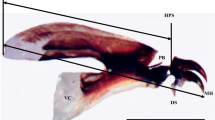Abstract
This paper analyses acarological evidence from a 130-year-old forensic investigation. It was the first case in forensic acarology, i.e., the first case where mites provided substantial information to estimate the post-mortem interval (PMI). In 1878, the mites found in the mummified body of a newborn baby girl in Paris, France, were studied by acarologist and forensic entomologist Jean Pierre Mégnin. Mégnin estimated around 2.4 million mites in the skull and identified them as Tyroglyphus longior (Gervais), a junior synonym of Tyrophagus longior. He suggested that the arrival of these mites at the corpse would have occurred by phoresy on carrier insects, roughly 5 months before the autopsy. There is no doubt about the identification of the mites, Mégnin was a highly respected acarologist. However, two main factors affecting the biology of Tyrophagus mites were not included in the original analysis. First, Mégnin stated that the mites were phoretic. However, he probably did not have access to information about the natural history of the species, because as a rule Tyrophagus mites are non-phoretic. Considering the omnipresence of Tyrophagus mites in soil, most likely the mites will have arrived almost immediately after death. Second, temperature was not taken into account during the estimations of the mite population growth rate. The new analysis is based on current knowledge of Tyrophagus biology and includes temperature, estimated following a handful of weather reports of the years 1877 and 1878. The new projections indicate that non-phoretic mites may have colonised the body just after death and the colony would have built up over 8 months, contrary to the 5 months proposed by Mégnin. This new lapse of time agrees with the PMI proposed by Brouardel: on 15 January 1878 he postulated the death of the newborn to have occurred some 8 months before the autopsy.
Similar content being viewed by others
References
Braig HR, Perotti MA (2009) Carcasses and mites. Exp Appl Acarol 49. doi:10.1007/s10493-009-9287-6
Brouardel P (1879) De la détermination de l’époque de la naissance et de la mort d’un nouveau-née, faite à l’aide de la présence des acares et des chenilles d’aglosses dans cadavre momifié [Determination of the time of birth and of death of a new-born child, made using the presence of mites and Aglossa caterpillars on the mummified corpse]. Ann Hyg Publ Méd Lég (série 3) 2:153–158
Eraky SA (1995a) Effect of temperature on the development of the copra mite, Tyrophagus putrescentiae (Schrank) (Acari: Acaridae). In: Kropczynska D, Boczek J, Tomczyk A (eds) The Acari. Physiological and ecological aspects of acari-host relationships. DABOR, Krynica, pp 205–210
Eraky SA (1995b) Some biological aspects of Tyrophagus putrescentiae (Schrank) (Acari: Acaridae). In: Kropczynska D, Boczek J, Tomczyk A (eds) The Acari. Physiological and ecological aspects of acari-host relationships. DABOR, Krynica, pp 197–204
Fisher RA (1930) The genetical theory of natural selection. Oxford University Press, Oxford
Fumouze A, Robin C (1867) Mémoire anatomique et zoologique sur les Acariens des genres Cheyletus, Glyciphagus et Tyroglyphus. J Anat Physiol 1867:561–601
Futuyma D (1998) Evolutionary biology. Sinauer Associates, Sunderland
Gervais P (1844) Aceres phryneides, scorpionides, solpugides, phalangides et acarides; diceres epizoiques, aphanipteres et thysonoures. In: Walckenaer CA (ed) Histoire naturelle des insectes vol. 3. Aptáeres, Paris, p 262
Hughes AM (1976) The mites of stored food and houses. Her Majesty’s Stationary Office, London
Kheradmanda K, Kamalia K, Fathipoura Y et al (2007) Development, life table and thermal requirement of Tyrophagus putrescentiae (Astigmata: Acaridae) on mushrooms. J Stored Prod Res 43:276–281
Mégnin P (1874) Mémoire sur les hypopes. J Anat Physiol 1874:225–254
Mégnin P (1894) La faune des cadavres. Application de l’entomologie à la médecine légale [The fauna of corpses. Application of entomology to forensic medicine]. G. Masson and Gauthier-Villars et Fils, Paris
OConnor BM (1982) Evolutionary ecology of astigmatid mites. Annu Rev Entomol 27:385–409
Perotti MA, Braig HR (2005) Endosymbionts of Acari. Phytophaga 14:457–476
Perotti MA, Braig HR (2009) Phoretic mites associated with animal and human decomposition. Exp Appl Acarol 49. doi:10.1007/s10493-009-9280-0
Perotti MA, Catala SS, Ormeno AD et al (2004) The sex ratio distortion in the human head louse is conserved over time. BMC Genet 5:10
Perotti MA, Braig HR, Goff ML (2009a) Phoretic mites and carcasses. In: Amendt J, Goff ML, Campobasso CP et al (eds). Current concepts in forensic entomology. Springer, Dordrecht
Perotti MA, Goff ML, Baker AS et al (2009b) Forensic acarology, an introduction. Exp Appl Acarol 49. doi:10.1007/s10493-009-9285-8
Samšiňák K (1960) Ueber einige myrmekophile Milben aus der familie Acaridae. Čas Česk Spol Entomol 57:185–192
Sanchez-Ramos I, Castañera P (2001) Development and survival of Tyrophagus putrescentiae (Acari: Acaridae) at constant temperatures. Environ Entomol 30:1082–1089
Schulze H (1924) Über die Biologie von Tyroglyphus mycophagus (Mégnin), zugleich ein Beitrag zur Hypopusfrage. Z Morphol Ökol Tiere 2:1–57
Treat AE (1975) Mites of moths and butterflies. Cornell University Press, Ithaca
Wrensch DL, Ebbert MA (1993) Evolution and diversity of sex ratio in insects and mites. Chapman & Hall, New York
Yovanovitch GP (1888) Entomologie appliquée à la médicine légale [Entomology applied to forensic medicine]. Ollier-Henry, Paris
Author information
Authors and Affiliations
Corresponding author
Rights and permissions
About this article
Cite this article
Perotti, M.A. Mégnin re-analysed: the case of the newborn baby girl, Paris, 1878. Exp Appl Acarol 49, 37–44 (2009). https://doi.org/10.1007/s10493-009-9279-6
Received:
Accepted:
Published:
Issue Date:
DOI: https://doi.org/10.1007/s10493-009-9279-6




